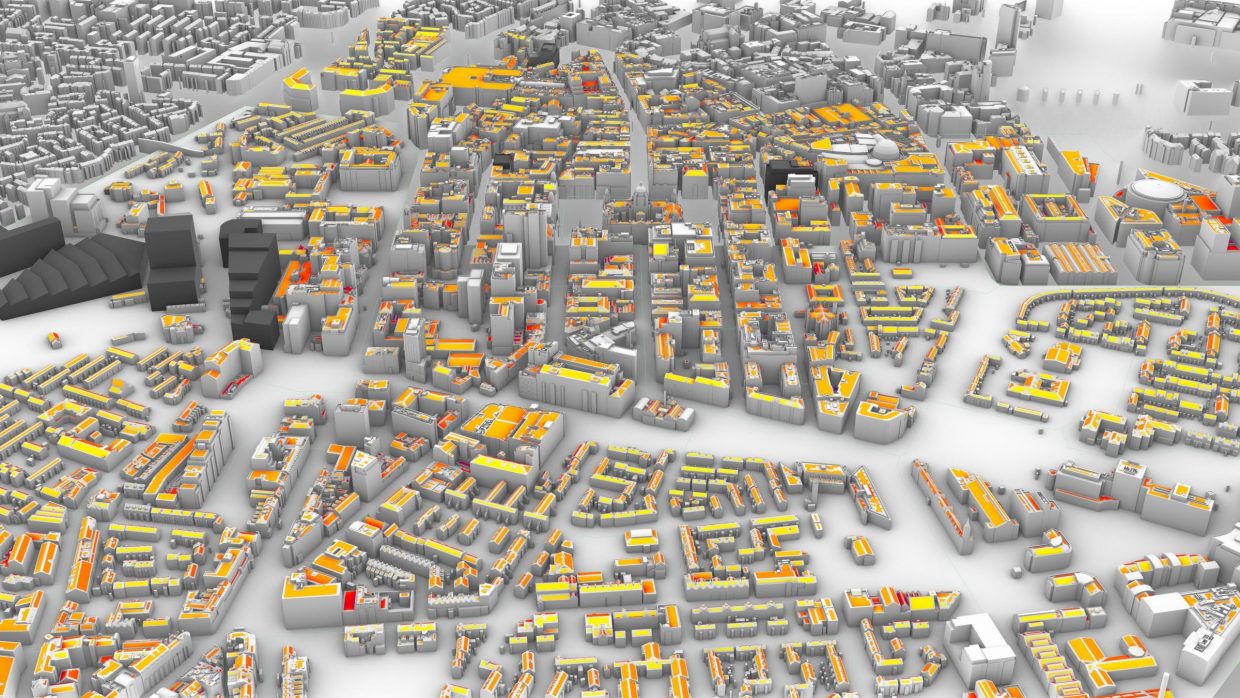As published in The Journal of RTPI Scotland Autumn 2024.
Justin McHenry, ESG and Solar PV Consultant at GIA Surveyors and RTPI Licentiate member who sits on the NI Young Planners Committee, discusses the work undertaken in NI to assess the potential contribution of urban solar photovoltaic energy towards net zero.
Amid growing climate challenges, solar photovoltaic (PV) energy has gained global attention. In the UK, this was underscored by the formation of the UK Solar Taskforce in 2023 and their upcoming Solar Roadmap Plan in 2024. Northern Ireland’s Energy Strategy, The Path to Net Zero (2021), initially set a target for 70% renewable electricity by 2030, later increased to 80% through the Climate Change Act (2022).
In line with these goals, Belfast City Council and the Department for the Economy NI commissioned GIA to assess solar PV potential across Belfast using advanced 3D modelling, along with expertise in daylight, energy and financial modelling, setting a new benchmark for solar energy analysis.
After a small-scale pilot assessing 60 government properties, the project expanded to cover a 3km² urban area, encompassing over 5,200 properties with diverse land uses and a mix of existing and planned developments. These factors play a key role in determining the effectiveness, suitability, and financial viability of PV installations.
The rationale for the project was to create a vital evidence base as to the potential contribution that urban solar PV across brownfield assets could make towards the renewable technology mix necessary to achieve net zero in Belfast; the NI local authority with the highest annual consumption of electricity per year. This evidence was then used to support renewable action planning, property retrofit programmes, including those aimed at addressing fuel poverty, asset decarbonisation programmes, local area energy planning, incentivisation scheme modelling and network upgrade planning.
The innovation of this project lies in the precision and scalability of its results. We achieved up to 97.5% accuracy in our PV performance estimates compared to real-world installations. This success is due to our rigorous analysis, which calculates the net usable roof or open space for each property, the performance potential of every individual panel, and accounts for contextual factors like shading, local climate data, and surrounding developments.
Lessons for Scotland
Our work highlights key learnings for Scotland and others to advance toward net-zero:
1.Urban solar PV can make a significant contribution to localised and national targets. The Belfast project evidenced that the existing building stock of circa 5,200 properties within a 3km2 could provide:
- 68,743kW of solar PV systems.
- 196,409 solar panels – all individually modelled and assessed for their electricity generation potential, carbon savings, revenue generation, contribution to self-sufficiency per property and payback.
- 39,270,180kWh/year of renewable energy production, with many areas demonstrating the potential to become almost fully self-sufficient, including fuel poverty areas.
- a payback period for the combined systems around 9.5 years with some as quick as 6 years.
- 14,565 tonnes co2e savings per year.
- 10% of the city centre’s total energy demand and 3% of Belfast’s entire electricity demand using a renewable source.
2.Collaborative working between central and local government, distribution network operators, the private sector and communities is crucial to effectively move projects from technical feasibility to implementation.
3.The development of large scale, interactive, urban technical assessments, such as that undertaken by us in Belfast, represents a fundamental starting point for any city, country or asset manager to understand how they can maximise their decarbonisation gains through PV while optimising financial investment.
Scotland’s Draft Energy Strategy and Vision for Solar includes a commitment to deploy between 4-6GW of PV by 2030; a commitment that requires the strategic and localised plans for commercial, domestic and utility-scale roof and ground-mounted solar.
GIA’s approach in Belfast demonstrates exactly how urban environments can help achieve these targets. If Belfast’s urban environment could produce approximately 10% of the city centre’s entire electricity demand annually, imagine the contribution possible to decarbonisation targets should Scotland follow suit across their existing building stock where, for example, Glasgow currently consumes 2,402.4GWh of electricity per year, Edinburgh 2,021.5GWh/year and Aberdeen 938GWh/year. Accurate, interactive, evidence bases are crucial to planning the renewable transition and mix of technologies required.


